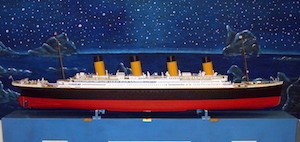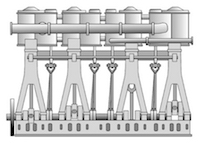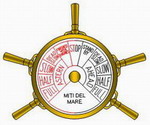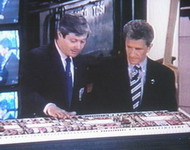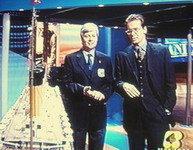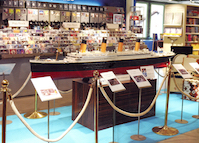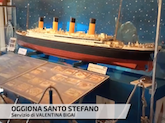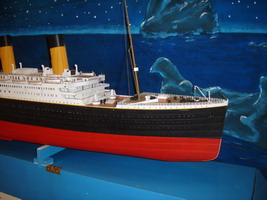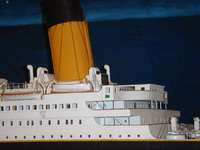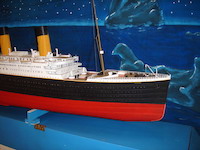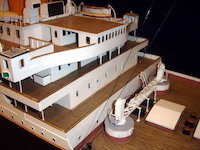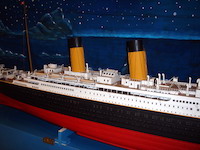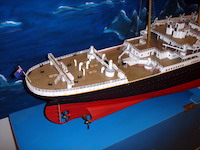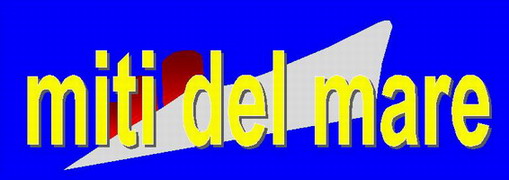 |
Welcome in the site mitidelmare.it If you like naval modellism, if you want to see models made by many enthusiasts, if You want some small constructive suggestion, start with the home page. Good navigation! |
 |
| Go to see the Titanic's photos ever published. They are spectacular photomontage made with the model described on this site.
|
|
| TITANIC
- The Artifact Exhibition - Torino 2017 : |
GUARDA LA PAGINA DELLA
CONFERENZA (IT) SEE THE CONFERENCE PAGE (EN) |
GUARDA IL
VIDEO DELLA CONFERENZA (IT) CONFERENCE VIDEO, ENGLISH VERSION (EN) |
| This model has
participated in several television broadcasts. Only the scenes in which
the model is present are reproduced here. These videos are reserved for visitors to this site and can not be downloaded or played in any way. |
| The ship We are in 1908. The White Star Line decides to build two ships, followed by a third: the Olympic class. These ships must offer luxury, speed and safety to compete with the competitor Cunard Mauretania and Lusitania. The construction is entrusted to the Harland & Wolff shipyards in Belfast. In March 1909 the Titanic was set up. The name is important and seems to fit perfectly with the massive transatlantic that is emerging. Nobody thinks about the novel of the American writer Morgan Robertson's published fourteen years earlier. It is told of a ship, the Titan, whose technical characteristics (size, power, speed, number of passengers, number of propellers, even number of life boats) are incredibly similar to those of the Titanic. Well, in the novel the Titan hits an iceberg in a cool month of April. It sinks fast, the life boats are not enough to accommodate all the passengers, and the number of victims is very high. |
Main technical features Length outside 882 '9 " Length between perpendiculars 850 '0 " Maximum width 92 '6 " Displacement 52,200 tons. Gross tonnage 46,300 tons. Alternative power output 30,000 HP Turbine power B.P. 16,000 HP |
| On April 10, 1912, the Titanic left
Southampton Harbor. On board there are 2200 people including the "crème" of the society of the time. From the luxury of the upper bridges, to the elegant second class, through the most modest third class destined for emigrants, down to the boiler rooms where sweaty stokers fired coal and discharge ash, the Titanic can well depict the stratification of the society of the time. The ship imperses the pride of an era, the excessive confidence in the possibilities of tecnology, the presumption of infallibility: it is in fact believed by many "unsinkable". Titanic heads to New York. The speed is 20.5 knots. On board entertain parties, hopes, illusions. The sea is calm. The temperature is very low. They are 23.40 on April 14, 1912. Suddenly the tragedy bursts. The two lookouts see a iceberg just 400 meters away. The alarm, the desperate approach to the left and the attempt to slow the race by bringing the machine telegraphs "All the strength back". Everything useless. The ship has just started evolving to the left when, with the hull, it strikes against the iceberg. During the crash, among the damaged plates, there are numerous waterways that are affecting five pond compartments. Too much for the ship to stay afloat. The order to leave the ship is imparted after only half an hour from the collision. Passengers, at first unbelieving, begin to go down badly on the life boats that move away, at least in the beginning, only partially charged. The ship plunges the bow more and more until the entire aft part is lifted from the water. At 2.18 of April 15, with a strong boom, it breaks between the second and the third chimney. The bow throw to the bottom and the stern, after a partial rotation, follows it. On board there are still over 1500 people. Seventy years later, in September 1985, a Franco-US scientific expedition found the wreck. The Titanic, broken in two trunks, lies at 4000 meters in depth at a point located at 49 ° 56 'west longitude and 41 ° 43' in Latidune North. |
| The
four top bridges of this model, namely the boats bridge, bridge "A",
bridge "B" and bridge "C" are fully furnished. Go visit
them! |
